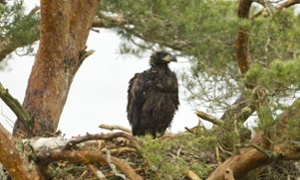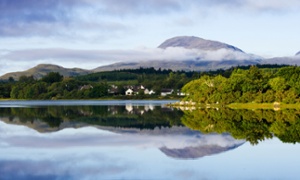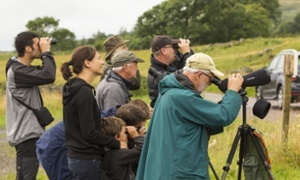We are lurching along the loch when the 25 seagulls hanging above our boat suddenly scatter. “It’s coming,” says David Sexton quietly. A dark shape materialises low over the water, gaining on us fast. With wings like planks and a meat-cleaver for a beak, the white-tailed eagle fixes its eyeballs (twice as large as ours) on the boat. Taking great scoops of air with each flap, it stretches yellow talons to pluck a fish from the water.
Britain’s biggest bird of prey passes three milestones this spring. It is 40 years since a revolutionary reintroduction programme began to return the white-tailed eagle, also known as the sea eagle, to the Scottish Highlands; 30 years since the first chicks fledged; and this year, the number of nesting pairs will exceed 100 for the first time. But for all the celebrations, some people still detest our biggest carnivorous creature.
If farmers see a sea eagle sat on a lamb, they aren’t going to ask whether it’s actually killed it
The most easily spotted animal pairing on the island of Mull is Mr and Mrs Goretex. Everywhere you go, holidaymakers train their binoculars on the twisting coastline, searching for sea eagles, golden eagles and otters. For David Sexton of the RSPB, the man responsible for managing the complex relationship between people and eagles here, spring is a stressful time. The birds are hatching chicks, vulnerable to late snow, and then he gets an early phone call. “It’s usually, ‘Your eagles are attacking my lambs,’” he sighs. Just that morning, a farmer found an eagle plucking at a dead lamb in a field. “I sympathise completely,” says Sexton. “Farmers are out from 5am until last light and when they see a sea eagle sat on a lamb, they aren’t going to ask whether it’s actually killed it. We’re not used to having a big predator around. It’s our version of the wolf in a way.”
Sexton takes me to Mull’s modest golf course. In the woods beyond is a white-tailed eagle nest the size of a treehouse. “The eagle with the sunlit eye”, as it is called in Gaelic, once flew everywhere from the Isle of Wight to the Shetlands. With its 8ft wingspan and massive nests, it is conspicuous and, unlike the notoriously wary golden eagle, an inquisitive animal. A totemic symbol for neolithic people who buried their dead with white-tailed eagles on Orkney, it was all too easily trapped, poisoned and shot to extinction, the last bird killed in 1918.
Over a decade from 1975, 82 young eagles were brought from Norway and released on the island of Rum. Typically, the eagles did things their way and flew over to Mull, where they began nesting. In 1984, Sexton came to the island to undertake covert nest surveillance. It was so secretive he even had a cover story – he was studying rare red-throated divers. At that point, the reintroduction was in crisis: none had bred successfully in nine years. During his first year, the only breeding pair’s nest failed. “It was a big disappointment. You’re not exactly incubating the eggs yourself but it feels like that,” he says. The next year, the same pair tried again: one chick survived to take its maiden flight. “It was a life-changing moment, really,” says Sexton.

Facebook Twitter Pinterest
A five-week-old white-tailed eagle chick in a nest in the Scottish Highlands. Photograph: Mark Hamblin/Rex/Shutterstock
We shelter from a torrential spring shower under some trees, a respectful distance from the eagles’ nest. When I peer through Sexton’s telescope, I’m not sure what is nest and what is bird. Then I realise: the female is half the nest, an enormous mound of mottled brown feathers. Sexton is relieved: “We know she’s OK and she’s sitting on her eggs.”
Augmented by further reintroductions on Wester Ross and Scotland’s east coast, a healthy population of British-born eagles, and a few Norwegian old-timers, now in their thirties, grace the Highlands. The reintroduction has proved a model for others around the globe, such as the Californian condor project, and also provides inspiration for the burgeoning rewilding movement and its ambitious moves to bring back beavers, lynx and even wolves.
But the story of the sea eagles shows that returning large animals to live among people who have no memory of residing alongside big predators is contentious. Mull covers a bigger area than Birmingham and its population is just 2,800. It appears wild and empty and yet human interests – and bird-disturbing bustle – is everywhere: not just sheep farming but forestry, hydro schemes, and the holidaymakers. While most visitors take a boat trip to see the eagles or visit a hide overlooking a nest, several photographers have been prosecuted for disturbing the birds by getting too close to nests.

Facebook Twitter Pinterest
The isle of Mull, Scotland, where the sea eagles have settled and bred successfully. Photograph: Alamy
Mary van Heerden is a member of Mull Eagle Watch. “When I saw my first sea eagle, I was completely hooked,” she says. “It was the size. When it flew over me I could see its eyes quite clearly and could hear the wind in its wings. It made the hairs on the back of my neck go up.” Van Heerden fled Zimbabwe for Mull 11 years ago. “I used to get so homesick. Once I found these eagles, it became a sort of therapy.” She names each bird (Chip and Putt; Seve and Monty) and guards them ferociously. The day before we spoke, she warned off a photographer. “I’m known as Eagle Mary in the village,” she says. “God help anybody who disturbs my birds.”
Advertisement
How much does Mull share Van Heerden’s love for its eagles? “The eagles have done a grand job bringing in visitors,” says David Clowes, who runs a guest house. But postcards of puffins and golden eagles far outnumber images of the reintroduced bird in shops. When I canvass opinion, everyone acknowledges the tourism dividend but several say there are now too many, or worry about the white-tailed eagles’ impact on other inhabitants – hares, golden eagles and farmers.
“Older people are more resistant,” thinks John Clare, a seasonal eagle ranger employed by a partnership between Forestry Commission Scotland, Police Scotland, Scottish Natural Heritage, the Mull & Iona Community Trust and the RSPB (which shows the institutional backing for this bird). “I’m great friends with an islander who has lived here all his life. He loves golden eagles but sees white-tailed eagles as interlopers.”
Golden eagles are smaller but more aggressive predators than white-tailed eagles, which often steal prey from other predators – crows, gannets and even otters. Sexton studies leftovers found in white-tailed eagles’ nests: these include everything from hedgehogs to herons, and the occasional lamb. Mull rumours say cat collars are found in nests (“a complete fabrication,” says Sexton – the eagles do snatch feral cats, which does all wildlife a favour). Critics also claim the eagles wipe out eider ducks (mink is the culprit, corrects Sexton) and Irish hares (another misconception, says Sexton: hare numbers have fallen partly because of disease). “Sea eagles get blamed for absolutely everything,” he says.
The fiercest opposition comes from farmers, even though some have holiday cottages and benefit from tourism. Lachlan MacLean farms 1,800 ewes with his brother. “The eagles are here to stay but I was better off before they were here,” he says. On the morning we spoke, two lambs had gone missing. One disappeared from a field where he has a “particular problem” with the eagles. “I’m 99% certain it was a sea eagle. It has a huge impact on your income. Last year I was able to identify 19 lamb carcasses on the ground. That was the ones I found.”

Facebook Twitter Pinterest
Tourists on wildlife tours on Mull are keen to catch a sight of the white-tailed eagle. Photograph: Warming Images/Rex/Shutterstock
Sexton has never witnessed a white-tailed eagle actually seize a lamb. The birds do swoop in after hooded crows or great black-backed gulls have attacked a lamb and pecked out its eyes but scientific studies in Scotland and Norway have found they rarely take live lambs. Sexton has watched the eagles ignore lambs in favour of apparently more difficult catches. “They seem focused on wild prey – I’ve seen them overfly a whole field of lambs and go for a greylag goose or snatch a rabbit caught by a buzzard.”
Has MacLean ever seen a white-tailed eagle take a lamb? “I’ve not actually seen it but I’ve found a number of lambs with talon marks in them,” he says. And he knows several people who have witnessed a white-tailed eagle “lift” a lamb. Scottish Natural Heritage last year acknowledged that white-tailed eagles do take lambs, and this year is offering financial assistance – up to £5,000 per farmer each year – to help farmers protect flocks from predation. But for MacLean, such sums do not compensate for the stress, and lost bloodlines when lambs are killed. “‘Eagle Island’ has been a huge attraction but now even some of the wildlife folk think there are too many,” he says. “There has to be some form of control on that but if they want to keep folk farming in this part of the world there also has to be proper compensation. We don’t just want to be here providing a food supply for the eagles.”
Farmers don’t just want to be here providing a food supply for the eagles
For all the conflict, no white-tailed eagles have ever been shot or poisoned on Mull, unlike in Ireland where a similar reintroduction programme is being sabotaged by persecution, with a poisoned female found dead on its nest last month. And Mull’s sheep farmers actually reported two injured eagles to Sexton in recent years – both were rehabilitated and released on to the island with the farmers’ blessing.
I take a trip on Lady Jayne. Its skipper, Martin Keivers, used to cut grass; now he makes a living from taking tourists to see the eagles. His boat bucks along the windy loch and, in the dark woodland beyond our vision, an eagle’s eye is caught by the gathering gulls. The enormous bird bears down on us and, at the last moment, Keivers throws a small dead fish into the water. A dozen holidaymakers’ camera shutters click furiously to catch the eagle’s swoop. “It’s like clay-pigeon shooting while trampolining” says Keivers of the camera skills required. “We’ve had people in tears as the birds come down.” Are the birds an accepted part of the landscape now? “Yes,” Keivers pauses. “Although people don’t want to see them sat on every lamppost.”

